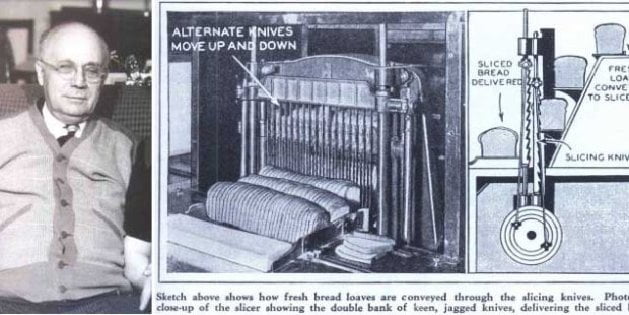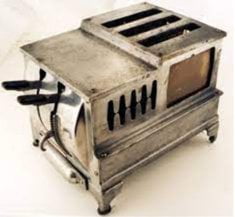
Otto Frederick Rohwedder, invented sliced bread and we are always telling people their idea is the greatest thing since sliced bread.
Does that mean that Otto Frederick Rohwedder the greatest inventor?
He was born in Davenport, Iowa, in 1880, from a German family and he lived there for most of his life, he even he died there when he was 92.
He started life as a jeweller who went on to own three shops. But in his heart, he was an inventor, and yes, he decided that he wanted to produce a bread slicing machine.
The Bread Slicing Machine
He was so incensed with the idea of a bread slicing machine that he sold his jewellery shops to fund his work on the slicing machine. Basically, he wanted to create a bread slicer that automatically cut loaves of bread into slices. He worked on several prototypes, including one that even held a sliced loaf together with metal pins. This model, and several others, would prove unsuccessful. Then disaster struck in 1917, a fire broke out in his workshop, everything went up in flames, even his blueprints and his prototype machine!
 Now he had to start again, and first he needed to find new funds. Then he had to deal with the questioning attitude from bakers, who thought factory-sliced loaves would quickly go stale or fall apart, so before he could complete it, he had to solve that problem. Eventually, after nearly 10 years, he had a successful working bread slicing machine. At last!
Now he had to start again, and first he needed to find new funds. Then he had to deal with the questioning attitude from bakers, who thought factory-sliced loaves would quickly go stale or fall apart, so before he could complete it, he had to solve that problem. Eventually, after nearly 10 years, he had a successful working bread slicing machine. At last!
Now he had to sell it.
He called it Rohwedder’s “power-driven, multi-bladed” bread slicer and persuaded his friend Frank Bench, who owned the Chillicothe Baking Company, to use it. It worked and it was popular.
The Electric Toaster is invented, but it kept catching fire!
 Otto’s timing was superb, you see sometime before, the electric toaster had been invented, but it had had a disappointing introduction as they kept catching fire! It took another inventor Charles Strite to solve this problem.
Otto’s timing was superb, you see sometime before, the electric toaster had been invented, but it had had a disappointing introduction as they kept catching fire! It took another inventor Charles Strite to solve this problem.
To explain, the first electric toaster had actually been invented by Alan MacMasters in London. It used electric filaments that had a large amount of nickel in their composition. This led them to overheat easily, so you got a lot of burnt toast, to which must be the added problem that you could only toast on one side of the bread at a time.
This is where Charles Strite came in. He realised this and spent many years working on ways to solve this problem and eventually he registered a US patent for a unit that could toast both sides and, more importantly, would pop the bread up when it was ready. Stopping the fires and burnt toast!
As I said it was perfect timing as due to the invention of the toaster there was a demand to buy bread loaves already cut, which meant that after the Chillicothe Baking Company started using his bread slicing machines all the bakeries wanted one.
Today, the toaster is a normal household fixture, which we think nothing of, but that was different 100 years ago before they had sliced bread or a toaster.
Finally, and this is fascinating, Charles Strite’s invention of a timer mechanism that let the toast pop-up when it was ready before it burnt, is the same mechanism that they use today.
So we must ask the question: was Otto Frederick Rohwedder the greatest inventor?
Isn’t history interesting?
10 questions to discuss:
- Beyond convenience: Did Rohwedder envision any other benefits or applications for his bread slicer beyond household convenience?
- Competing ideas: Were there any other inventors working on similar bread slicing machines during Rohwedder’s time? If so, what made his design stand out?
- Impact on bakers: How did the adoption of sliced bread impact the working practices and economics of bakeries?
- Beyond sliced bread: What other food products were eventually impacted by the invention of slicing technology?
- Stalemate challenge: How did Rohwedder overcome the skepticism about sliced bread going stale quickly, and what solutions did he develop?
- Sliced bread and culture: Has the availability of sliced bread influenced food culture or meal preparation habits in any way?
- Innovation vs. iteration: Do you think Rohwedder’s invention is better characterized as groundbreaking innovation or a practical iteration of existing technology?
- Unsung heroes: Are there other inventors like Strite, who made crucial contributions to popular products but are less well-known than the initial patent holder?
- Evolution of household appliances: How has the development of the toaster, alongside sliced bread, influenced the design and functionality of other kitchen appliances?
- Greatest invention? How would you define “greatest invention”? Does Otto Frederick Rohwedder’s work fit that definition considering the broader context and contributions of others?
We hope that these questions will encourage critical thinking and discussion beyond the basic facts described here.
For more information on this go to:
http://www.historyofbread.com/bread-history/history-of-sliced-bread/

